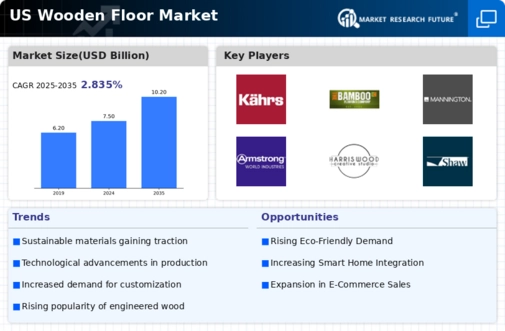Growing Awareness of Indoor Air Quality
The wooden floor market is increasingly shaped by the rising awareness of indoor air quality and its impact on health. Consumers are becoming more conscious of the materials used in their homes, leading to a preference for flooring options that contribute to better air quality. Wooden floors, known for their natural properties, are perceived as healthier alternatives to synthetic flooring materials that may emit volatile organic compounds (VOCs). In 2025, it is estimated that 45% of consumers prioritize indoor air quality when selecting flooring, which significantly influences purchasing decisions in the wooden floor market. This trend encourages manufacturers to focus on producing low-VOC and sustainably sourced wooden flooring, thereby enhancing their market appeal. As health considerations continue to gain prominence, the wooden floor market is likely to adapt and innovate to meet these consumer demands.
Technological Innovations in Manufacturing
The wooden floor market is experiencing transformative changes due to technological innovations in manufacturing processes. Advances in production techniques, such as precision milling and automated finishing, enhance the quality and consistency of wooden flooring products. In 2025, it is projected that the adoption of these technologies could reduce production costs by up to 15%, allowing manufacturers to offer competitive pricing while maintaining high standards. Additionally, innovations in design and customization options enable consumers to select unique finishes and styles, further driving demand in the wooden floor market. As technology continues to evolve, manufacturers are likely to invest in research and development to create more efficient and sustainable production methods, positioning themselves favorably in a competitive landscape.
Expansion of Home Improvement Retail Channels
The wooden floor market is benefiting from the expansion of home improvement retail channels, which provide consumers with greater access to a variety of flooring options. In 2025, the home improvement sector is expected to grow by 7%, driven by increased consumer spending on home renovations and upgrades. Retailers are diversifying their offerings, including a wider range of wooden flooring products, which enhances consumer choice and convenience. This trend is particularly evident in the rise of online retail platforms, where consumers can easily compare products and prices. The wooden floor market is likely to capitalize on this trend by enhancing its online presence and marketing strategies. As retail channels continue to evolve, the wooden floor market is positioned to reach a broader audience, ultimately driving sales and market growth.
Increased Investment in Residential Construction
The wooden floor market is positively influenced by the ongoing investment in residential construction across the United States. In 2025, the residential construction sector is projected to grow by 5%, leading to heightened demand for flooring solutions, particularly wooden options. This growth is attributed to factors such as low mortgage rates and a robust job market, which encourage home buying and renovations. As new homes are built and existing ones are remodeled, the wooden floor market stands to gain significantly. The preference for wooden flooring in upscale homes further drives this trend, as homeowners seek to enhance property value and aesthetic appeal. Consequently, the wooden floor market is positioned to capitalize on the expanding residential construction landscape, with opportunities for innovation and product differentiation.
Rising Consumer Preference for Natural Materials
The wooden floor market experiences a notable surge in demand as consumers increasingly favor natural materials over synthetic alternatives. This shift is driven by a growing awareness of environmental sustainability and health implications associated with artificial flooring options. In 2025, approximately 60% of homeowners express a preference for natural wood flooring, indicating a significant trend towards eco-friendly choices. The wooden floor market benefits from this consumer inclination, as it aligns with the broader movement towards sustainable living. Furthermore, the aesthetic appeal and durability of wooden floors contribute to their desirability, making them a preferred choice for both new constructions and renovations. As consumers prioritize quality and sustainability, the wooden floor market is likely to see continued growth, with manufacturers adapting their offerings to meet these evolving preferences.






















Leave a Comment